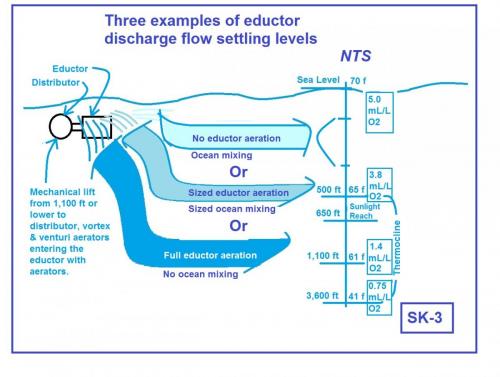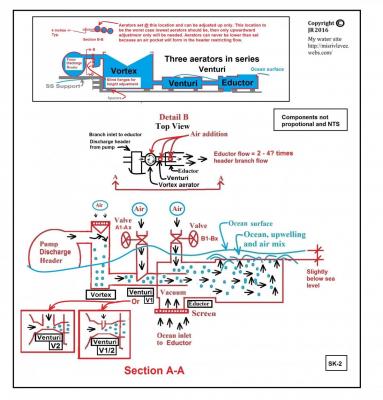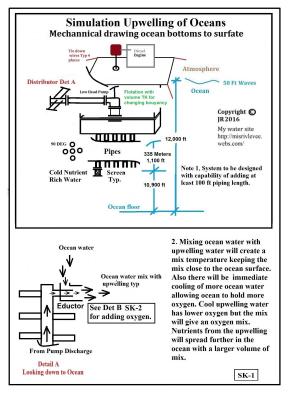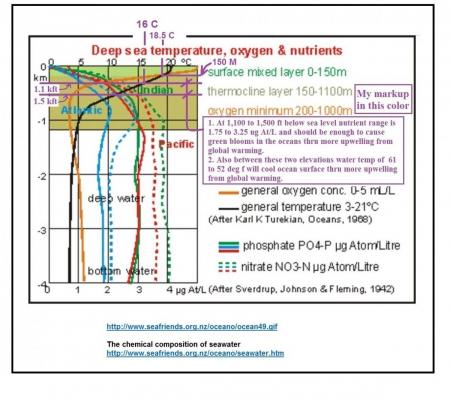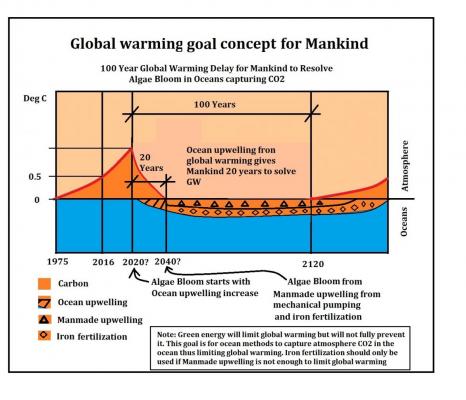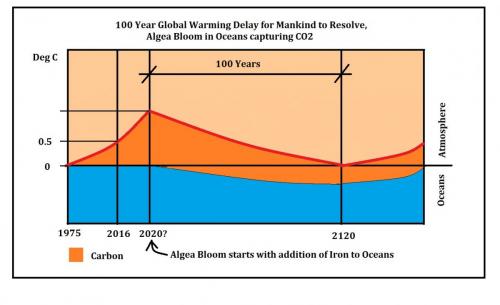

Ken123
Members-
Posts
29 -
Joined
-
Last visited
Profile Information
-
Favorite Area of Science
Streams
Ken123's Achievements

Quark (2/13)
2
Reputation
-

Iron in ocean to grow Plankton and capture CO2 in the atmosphere:
Ken123 replied to Ken123's topic in Earth Science
Kind of ran with your idea and may have found a way of aerating the mechanical upwelling water. Any thoughts would be greatly appreciated. Please see pictures below. One example: O2 for oceans at different depths. The system will have 6 eductors and 3 eductors on one side can be set for discharge to sunlight reach depth and 3 on the other side can be set for settling in the thermocline. Note, to settle at the thermocline the eductor has to have full aeration so there is no ocean water mixing and water temperature will be close to thermocline water temperature of 1,100 ft */-. Abstract Global warming can be reduced by plankton growth, which provides a sizeable contribution to decreasing atmosphere temperatures. Plankton growth comes by four means, natural ocean upwelling of nutrient-rich ocean water (A process in which deep, cold water rises toward the surface), increased ocean upwelling from global warming, mechanical simulation of waters upwelling from the ocean depth and if necessary, limited iron fertilization for reducing global warming. Reducing global warming by a concept of mechanical simulation of ocean upwelling is described in this book. By lifting ocean water from 1,100 feet below sea level to the ocean surface a plankton bloom will be formed. Flow from the mechanical lift will have oxygen added thru vortex aeration, ventures and eductors with the eductors mixing upwelling water with ocean water and air, then discharging at 100 KGPM or about 500 square miles per year at a depth of 6 Inches. One method of mixing will discharge at 66 f and settle 500 ft below sea level with same ocean water properties or higher because heating from surrounding waters . Sunlight travels 650 ft deep and plankton can grow at this depth. A 500 HP pump (Size of a large truck engine) is needed to do this and please see attached sketches. This concept will provide plankton blooms by way of nutrients and oxygen-rich (Because of aeration) cold waters mixed with the ocean, thus sequestering CO2 from the atmosphere and reducing global warming. If the system could be installed on oil platforms, cost will be reduced. And If interested in demonstrating this concept by lab simulation or other means, please contact me at pfsfst@cox.net or at my website. Eductor operation Eductor vacuum will change as a function of aeration flow change and this changing vacuum regulates eductor input water flow. For full aeration flow, input water flow to the eductor is 0 GPM and for no aeration flow, input water flow is maximum. Three examples: · For the sized eductor/aeration flow with motive water flow scaled to 1 and input water flow scaled to 1 (See 2. below). · For no aeration flow, input water flow is greater than 1 (See 1. below). · For full aeration flow, input water flow is 0 GPM (See 3. below). 1. For no eductor aeration flow and motive water flow of 1, input water flow is greater than 1. Eductor discharge temperature will be greater than 18.5 C (About 65 f) and will settle above 150 M depth (About 500 ft). Sunlight travels 200 M (656 ft) deep and plankton can grow at this depth. 2. For the sized eductor/aeration flow with motive water flow of 1 and input water flow of 1, eductor discharge temperature will be 18.5 C (About 65 f) and flow will settle at 150 M depth (500 ft). Sunlight travels 200 M (650 ft) deep and plankton can grow at this depth. 3. For eductor full aeration flow and motive water flow of 1, input water flow is 0 GPM. Eductor discharge temperature will be 16 C (About 61 f) and will settle at 335 M depth (About 1,100 ft). Sunlight travels 200 M (650 ft) deep and plankton cannot grow at this depth. -

Iron in ocean to grow Plankton and capture CO2 in the atmosphere:
Ken123 replied to Ken123's topic in Earth Science
Update to global warming concept goal drawing Competition between global warming Earth's energy ...A collapse of the Atlantic Meridional Overturning Circulation (AMOC) leads to global cooling through fast feedbacks that selectively amplify the response in the Northern Hemisphere (NH). How such cooling competes with global warming has long been a topic for speculation, but was never addressed using a climate model. Here it is shown that global cooling due to a collapsing AMOC obliterates global warming for a period of 15–20 years... Some indications of freshwater effects. ...One of the characteristics of the AMOC shutdown is a TOA radiation anomaly associated with increased ocean heat uptake24,25,26. In coupled climate models a shutdown of the AMOC is artificially forced by releasing large amounts of freshwater in the North Atlantic27, motivated by the fact that climate models cannot yet correctly simulate past abrupt climate change including an AMOC collapse28, affecting the likelihood of simulating future abrupt climate change29,30. None of the previous freshwater hosing experiments investigated the competition between a complete, permanent AMOC collapse, and greenhouse gases forcing acting simultaneously. In one case the AMOC was collapsed during a transient greenhouse scenario run by applying a sudden large freshwater pulse over just one time-step31, after which the AMOC recovered from its collapse, leading to a different interplay between radiative forcing and ocean dynamics from what is discussed here. Here, the impact of an AMOC collapse is analysed from an experiment in which persistent hosing, forcing the AMOC to remain in a collapsed state, is combined with increasing CO2 forcing, focusing on how they modify the ocean heat uptake and TOA radiation imbalances, and how these anomalies translate into different surface warming signals... Competition between global warming and an abrupt collapse of the AMOC in Earth’s energy imbalance Published online: 06 October 2015 http://www.nature.com/articles/srep14877 -

Ocean limited upwelling considerations for global warming
Ken123 replied to Ken123's topic in Earth Science
I may have posted incorrectly. Looked up blog definition and my post need to be in a blog. Will take time to see what post should be published on the forum. -

Ocean limited upwelling considerations for global warming
Ken123 replied to Ken123's topic in Earth Science
Competition between global warming Earth's energy ...A collapse of the Atlantic Meridional Overturning Circulation (AMOC) leads to global cooling through fast feedbacks that selectively amplify the response in the Northern Hemisphere (NH). How such cooling competes with global warming has long been a topic for speculation, but was never addressed using a climate model. Here it is shown that global cooling due to a collapsing AMOC obliterates global warming for a period of 15–20 years... Competition between global warming and an abrupt collapse of the AMOC in Earth’s energy imbalance Published online: 06 October 2015 http://www.nature.com/articles/srep14877 -

Ocean limited upwelling considerations for global warming
Ken123 replied to Ken123's topic in Earth Science
Seems like there will be more upwelling from global warming. Three articles about ocean upwelling in conflict. Article 1 shows more upwelling from global warming but article 2, I posted a few days, shows less upwelling. The article 2 link worked then but does not work now. Found the article by searching a phrase in the article and is a dead link. The #1 type information may have brought about the #2 article being closed. Article 1 reference is 2015 but did not get article 2 date because of the dead link. Article 3 2015 backs up article 1 in terms of global warming will increase upwelling. Article 1 ...Ecosystem productivity in coastal ocean upwelling systems is threatened by climate change. Increases in spring and summer upwelling intensity, and associated increases in the rate of offshore advection, are expected. While this could counter effects of habitat warming, it could also lead to more frequent hypoxic events and lower densities of suitable-sized food particles for fish larvae. With upwelling intensification, ocean acidity will rise, affecting organisms with carbonate structures. Regardless of changes in upwelling, near-surface stratification, turbulent diffusion rates, source water origins, and perhaps thermocline depths associated with large-scale climate episodes (ENSO) maybe affected. Major impacts on pelagic fish resources appear unlikely unless couples with overfishing, although changes toward more subtropical community composition are likely. Marine mammals and seabirds that are tied to sparsely distributed nesting or resting grounds could experience difficulties in obtaining prey resources, or adaptively respond by moving to more favorable biogeographic provinces... Anticipated Effects of Climate Change on Coastal Upwelling Ecosystems http://link.springer.com/article/10.1007/s40641-015-0008-4 Current Climate Change Reports June 2015, Volume 1, Issue 2, pp 85–93 Article 2 Upwelling and trade winds < Batture > 2016-12-30 16:54 ..How will global warming affect upwelling and coastal productivity? The strong dependency of upwelling processes on the strength of trade winds contains one hint. Remember that trade winds are zonal winds, which feed off the latitudinal temperature gradient. As this gradient weakens (high latitudes being warmed more than low, in all computer simulations), zonal flow will weaken. Monsoons, as we have seen, would be favored over trades. Thus, the upwelling that derives its energy from trade winds will weaken. Indeed, off California, upwelling of cold water has become less common since 1975, and the productivity of the California Current has diminished accordingly. A comparison of phytoplankton concentration during upwelling periods off the coast of Peru: (A) 1983, a severe El Niño and (B) 1985, a non-El Niño period. Note how much smaller the bloom (circled) is during El Niño conditions, when nutrient upwelling ceases. The color key needed to read the phytoplankton concentrations is the same as that in the above satellite image. (From: NASA) A similar decrease in productivity may be expected elsewhere in the eastern boundary currents, and in the eastern equatorial high production regions. Upwelling that depends on monsoon activity (as in the Arabian Sea) should be much less effected, or even benefit from the change.... Upwelling and Climate http://earthguide.ucsd.edu/virtualmuseum/climatechange1/11_2.shtml Article 3, 2015 Global warming to increase ocean upwelling, but fisheries impact uncertain http://oregonstate.edu/ua/ncs/archives/2015/feb/global-warming-increase-ocean-upwelling-fisheries-impact-uncertain -
knowing global warming is limiting ocean upwelling thus plankton blooms, how much upwelling has been limited in the past and more important how much this limited upwelling has contributed to limited plankton blooms thus contributed to global warming? If limited upwelling has great impact to global warming then considerations for mechanically drawing ocean water bottoms to the top should be actively explored. There is about 10% CO2 removal from the atmosphere by way of new plankton blooms from iron fertilization but may have higher atmosphere CO2 affect because of the upwelling concern. One year carbon tax pays for 10 ocean bottoms pumping systems magnitude cost $2 Billion(TBD). A carbon tax of $2.2 Billion /Yr = 180 MM tones of LPG Global Carbon produced /Yr Picture of mechanical oceans bottoms uplift System concept: http://i66.tinypic.com/idt25x.jpg Carbon tax: Picture of carbon tax http://i68.tinypic.com/2vlrwx2.jpg http://carbonsolutio.../Calculator.php LPG produced per year: Picture of LPG produced per year http://i63.tinypic.com/2llzwbs.jpg http://www.poten.com...ts-Jan-2016.pdf Reference pictures, calculations and pump information. AXIAL FLOW PUMP and line drop: Picture of flow curve http://i65.tinypic.com/nz3jts.jpg http://www.ensival-moret.com/-products-CAHRM-CAHRK-?lang=en Pressure Drop Online-Calculator Picture of calculation http://i66.tinypic.com/5ed36o.jpg http://www.pressure-...ine-Calculator/ Picture of KE calculation http://i63.tinypic.com/2n1do54.jpg
-
On a different Thread I shared a possible solution: http://www.scienceforums.net/topic/101950-iron-in-ocean-to-grow-plankton-and-capture-co2-in-the-atmosphere/ Posted Today, 07:12 PM Ken123, on 30 Dec 2016 - 6:45 PM, said: Picture of mechanical oceans bottoms uplift System concept: http://i66.tinypic.com/idt25x.jpg One year carbon tax pays for 10 ocean bottoms pumping systems magnitude cost $2 Billion(TBD). A carbon tax of $2.2 Billion /Yr = 180 MM tones of LPG Global Carbon produced /Yr Carbon tax: Picture of carbon tax http://i68.tinypic.com/2vlrwx2.jpg http://carbonsolutio.../Calculator.php LPG produced per year: Picture of LPG produced per year http://i63.tinypic.com/2llzwbs.jpg http://www.poten.com...ts-Jan-2016.pdf Ken123, on 31 Dec 2016 - 12:54 PM, said: AXIAL FLOW PUMP and line drop: Picture of flow curve http://i65.tinypic.com/nz3jts.jpg http://www.ensival-moret.com/-products-CAHRM-CAHRK-?lang=en Pressure Drop Online-Calculator Picture of calculation http://i66.tinypic.com/5ed36o.jpg http://www.pressure-...ine-Calculator/ Picture of KE calculation http://i63.tinypic.com/2n1do54.jpg
-

Iron in ocean to grow Plankton and capture CO2 in the atmosphere:
Ken123 replied to Ken123's topic in Earth Science
Picture of mechanical oceans bottoms uplift System concept: http://i66.tinypic.com/idt25x.jpg One year carbon tax pays for 10 ocean bottoms pumping systems magnitude cost $2 Billion(TBD). A carbon tax of $2.2 Billion /Yr = 180 MM tones of LPG Global Carbon produced /Yr Carbon tax: Picture of carbon tax http://i68.tinypic.com/2vlrwx2.jpg http://carbonsolutions.com/Calculator.php LPG produced per year: Picture of LPG produced per year http://i63.tinypic.com/2llzwbs.jpg http://www.poten.com/wp-content/uploads/2016/02/LPG-in-World-Markets-Jan-2016.pdf AXIAL FLOW PUMP and line drop: Picture of flow curve http://i65.tinypic.com/nz3jts.jpg http://www.ensival-moret.com/-products-CAHRM-CAHRK-?lang=en Pressure Drop Online-Calculator Picture of calculation http://i66.tinypic.com/5ed36o.jpg http://www.pressure-drop.com/Online-Calculator/ Picture of KE calculation http://i63.tinypic.com/2n1do54.jpg -

Iron in ocean to grow Plankton and capture CO2 in the atmosphere:
Ken123 replied to Ken123's topic in Earth Science
knowing global warming is limiting ocean upwelling thus plankton blooms, how much upwelling has been limited in the past and more important how much this limited upwelling has contributed to limited plankton blooms thus contributed to global warming? If limited upwelling has great impact to global warming then considerations for mechanically drawing ocean water bottoms to the top should be actively explored. I remember reviewing about 10% CO2 removal from the atmosphere by way of new plankton blooms from iron fertilization but there may be a higher atmosphere CO2 affect because of the upwelling concern. I will try to see if there are any articles on this. -

Iron in ocean to grow Plankton and capture CO2 in the atmosphere:
Ken123 replied to Ken123's topic in Earth Science
Thanks, greatly appreciated. -

Iron in ocean to grow Plankton and capture CO2 in the atmosphere:
Ken123 replied to Ken123's topic in Earth Science
Looked at the links but could not find "These thermoclines block the natural upwelling of nutrient-laden cooler water from the bottom to the surface". Also looking for how the blocks happen. Please check. Thanks -

Iron in ocean to grow Plankton and capture CO2 in the atmosphere:
Ken123 replied to Ken123's topic in Earth Science
Thanks, I made a preliminary matrix of concerns and resolutions for iron fertilization. Will need to adjust as I learn. I have studied articles on each item and the resolutions are shown in the articles. If anyone is interested in an item please request and will send the excerpt and link.associated with the item. Grow plankton with iron to reverse global warming Number Concern Resolution Reference 1 Red Tide Red tides have not been known to happen in open oceans where iron fertilization was executed 2 Dead zones Dead zones have not been known to happen in open oceans where iron fertilization was executed 3 More Carbon in the oceans Acceptable for 100 years because CO2 will be less in the atmosphere 4 Carbon not on ocean floor Not a concern because carbon will be in the water column 5 Carbon in water column Acceptable because less carbon in the atmosphere 6 Carbon acidify oceans Iron fertilization w/ green bloom captures CO2 from the atmosphere minimizing CO2 captured by the oceans with less acidification of oceans 7 Oceans do not remove CO2Incorrect because air-water interface are equilibrated 8 Globe is presently too hot Almost immediate action for iron fertilization of oceans is needed to quickly remove CO2 from the atmosphere and the globe will cool 9 Fillings are steel and not pure iron Use pure iron fillings for the fertilization 10 Ice melting Cooling the globe with iron fertilization cools ice, generates less active storms, less rain and 11 More active storms sea level not rising 12 More rain 13 Sea level rise Matrix Global Warming.doc -

Iron in ocean to grow Plankton and capture CO2 in the atmosphere:
Ken123 replied to Ken123's topic in Earth Science
Thanks for the insight. Will review. -

Iron in ocean to grow Plankton and capture CO2 in the atmosphere:
Ken123 replied to Ken123's topic in Earth Science
Farm the Oceans to Help Stop Global Warming It’s a controversial idea—but it’s already happening anyway. By David Biello 2016-12-24 00:34 http://www.slate.com/articles/technology/future_tense/2016/11/how_dumping_iron_in_the -

Iron in ocean to grow Plankton and capture CO2 in the atmosphere:
Ken123 replied to Ken123's topic in Earth Science
Global Warming delayed for Mankind to resolve. Oceans capture CO2 from the atmosphere for 100 years by adding Iron to the oceans generating algae blooms with CO2 levels decreasing in the waters. The ocean waters strip CO2 from the atmosphere as the ocean algae increase. After 100 years carbon is released back to the atmosphere by sea life exhaling CO2. Concept sketch

